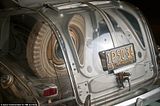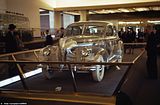Dubbed the 'Ghost Car', is a Pontiac Deluxe Six which, bizarrely, has been covered in Plexiglas.
Built in 1939 by General Motors and chemical company Rohm and Haas at a cost of $25,000, it was the first transparent full-sized car to be made in America.
Billed as a vision of the future, it was made for the 1939-40 New York World's Fair, where it became a sensation at General Motors' 'Highways and Horizons' pavilion; and it continues to cause a stir today.
Just two were ever made and this model, which has a three-speed manual transmission, and is thought to be the last of its kind.
It has clocked up just 86 miles in its lifetime; and now its set to go on sale for the first time since the early 1980s. It last sold for an undisclosed amount.
Once their respective showcases had closed, both 'Plexiglas Pontiacs,' or 'Ghost Cars' as they were sometimes known, toured the nations dealerships. The 1939-40 Deluxe Six is the only one known to survive.
Following the dealership tour, it went on display at the Smithsonian Institution in Washington, D.C. and was reportedly there until 1947.
It was later owned by a succession of Pennsylvania Pontiac dealers. It appeared at the first annual meet of the new Pontiac-Oakland Club International in 1973 and was purchased by Don Barlup of New Cumberland, Pennsylvania. Barlup commissioned a partial restoration from S&H Pontiac of Harrisburg and sold it to collector Leo Gephart in 1979.
The current owners father purchased it from Gephart in the early 1980s, and it has remained in the same family ever since.
Not surprisingly, it has no conventional vehicle identification number; even the machined boss for the engine number is blank.
The car has was the result of a collaboration between General Motors and Rohm & Haas, who developed the ground-breaking material Plexiglas in 1933.
The material went on to be used in military planes during World War II and then expanded in to signs, lighting, fixtures, trains and other cars.
Rohm & Haas used drawings for the Pontiac four-door Touring Sedan to create an exact replica body out of the transparent acrylic.
It was completed with structural metal underneath, which was given a copper wash, and chrome-plated hardware.
Rubber moldings were made in white, as were the cars tires. The only recent mechanical work has been replacement of the fuel lines.
The model also boasts an L-head six-cylinder engine, coil spring independent front suspension, live rear axle with semi-elliptic leaf springs, and four-wheel hydraulic drum brakes.
According to the GM Heritage Center, a second car, on a Torpedo Eight chassis, was hurriedly constructed for the 1940 Golden Gate Exposition on Treasure Island, a man-made island in San Francisco Bay. |

One of a kind: The 1939 motor is a Pontiac Deluxe Six which has been covered in Plexiglas, developed just a few years earlier in 1933

Innovative: General Motors and chemical company Rohm and Haas built the vehicle for $25,000 - an astronomical price during the 1930s

Not for touring: The collectible is unlikely to be seen on the road

Transparent: Wires and a spare wheel can be seen through the trunk of the car

Sensation: Billed as a vision of the future, the car was made for the 1939-40 New York World's Fair in San Francisco, pictured here

Vintage: The Transparent Car, on display at General Motors' 'Highways and Horizons' pavilion in 1939, has continued to cause a stir since its debut
|




